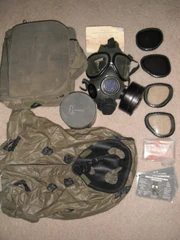
Mask, Protective Field, M40. With Carrier, M40/M42 Mask, Hood, M40/M42 First Generation, Canister, Filter, C2, Outserts, Lens, Clear and Neutral Gray, Bag, Waterproofing, MI, Manual, Mask, Chemical-Biological, M40/M42, and Flash Cards, PMSC.
The M40 Series Field Protective Masks were created as a much-needed replacement for the M17 Series Field Protective Masks, which had stayed in service since 1959 up until 1992 (and 1994 as a training and special purpose mask, and was further used by civilians alongside the M9A1) and its stay was becoming undesirable.
At the time, the M17 was a very good protective mask which had very good qualities such as a drinking device to replenish fluids while wearing the mask (M17A1 and M17A2), internal M13 Series Filter Elements which prevented leaks, and even at one point, a special resuscitation tube assembly to perform CPR to another soldier during a gas attack (but the tube was faulty and was dropped around 1983 from its conception with the M17A1 in 1966).
However the M17 Series had several problems - the internal filter elements were difficult to replace and could not be replaced in the heat of battle, like threaded filters could. The M17 series also had the downside of bulk; having two filter elements in the faceblank added weight to the mask. They were also quite uncomfortable, as the M17's blended natural rubber facepiece was not as supple as the older M9 Series gas masks and many other masks from WWII. Additionally the M17's facepiece was not texturized on the inside - this smooth design caused excessive sweating, which could degrade the rubber quality of the mask. Due to these flaws, a replacement was open for discussion.
Further History and Design
In the 1970's the Army experimented with a new type of mask known as the XM29 and XM30 series. These
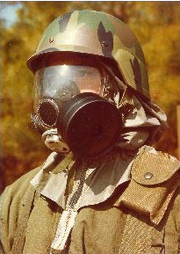
The XM-29 Protective Mask. Problems with this mask is what helped inspire the Army to reconsider their values and make the M40.
masks, however had several problems with the panoramic eyepiece as well as the fact that the silicone rubber it was made of was prone to blister agents, which degrade silicone. The Navy and Air Force loved the design and finalized it as the MCU-2/P.
Learning from their mistakes, the Army decided to start over. In 1984, the ILC Dover company came out with the first prototype of the mask - the XM40. It was a very loose design, but it helped pave the way towards the development of the M40.
Later, another XM40 prototype was designed - it was similar to the first, but was much more solid, and so much so, that it was thought they would just keep that design and mass-produce it. But alas, further testing was needed, especially due to complaints of the XM40 series' bulk.
Around the late 1980's the XM40 was finalized as the M40 Field Protective Mask, but it did not enter service until after the Gulf War (which the M17A2 was mainly used), because at the time, they only had limited numbers of M40 masks, and a sudden change in gas mask style could cause confusion. It was mass-produced and mainstay issued in 1992.
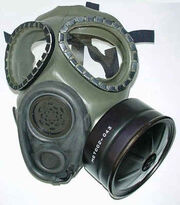
The 1984 ILC Dover XM40, one of the original prototypes for the M40. As you can se, the design was greatly influenced of the M17A1/M17A2 Masks. That round dimple under the voice diaphragm was pushed down in order to clear the mask better, when clearing and sealing. This feature was dropped in later XM40 prototypes, but this design, while loose, is a very important milestone in gas mask history.
It had two large, polygonal, binocular sight plexiglas eyepieces (which to me resembled Sovet WWII/Cold War Tanker and Pilot Goggles), which came with a seperate pair of ballistic lens "outserts", like its cousin, the M17, but these outserts also came in a neutral grey (tinted) version for protection against UV rays and flashbang grenades. It had a large voice diaphragm (same as on the MCU-2/P Series) which had threads on the inside to fit an M7 or MSA Voice Amplification Unit. The outlet valve had a drinking tube built into it, which wrapped around the outlet valve cover and fit in a pocket on the cover (again, simillar to the MCU Series).
The mask's inside had an in-turned face seal periphery to improve the seal, and the chin cup had a groove (a slit in the rubber), that drained excess sweat and moisture out the exhale valve. The orinasal cup was the same type as on the MCU-2/P. It used a 40mm threaded C2 canister which could be switched out on either side with a secondary side voice diaphragm (used for telephone communication) to accommodate left and right-handed rifle users.
The facepiece was made of Olive Drab Silicone rubber, like the XM40 Series, but this time, due to experiments, they had a plan - they created a special hood made of Butyl Rubber-coated Nylon and had a specially made sheet of Butyl Rubber, sewn into the hood, that covered the facepiece, protecting the silicone facepiece from the harmful effects of blister agents. The Butyl Rubber "second skin" fastened to the facepiece with velcro patches near the bottom of the exhale valve, where a part of the hood curled under that had the patches to fasten on.
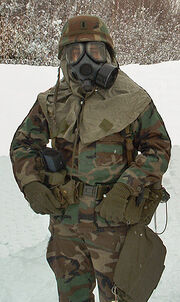
The M40 Field Protective Mask in use.
The second skin wasn't sewn to the bottom of the hood, in order to pull the bottom of the hood over the outlet valve to maintain positive pressure in the hood. This feature and the fact that the second skin fastened with velcro, made the whole assembly prone to leaks, so an update was needed.
In the mid-1990's, the M40 was updated and re-designated the M40A1. It had a new oronasal cup, made of olive drab silicone, and was more smoothly made, instead of the choppy-looking MCU-2/P oronasal cup used on the M40. The hood and second skin were replaced as well - The second skin was a separate piece of molded butyl rubber, that once put on the mask, was meant to stay there (aside from cleaning or replacing when broken).
This new second skin did not cover the parts of the mask where the head harness buckles were attached, and had a up-raised peak of rubber, similar to the British S10 Facepiece, all around the edge of the skin. This was meant to help hold the new M40A1/M42A1 "Quick Doff" Chemical
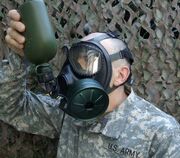
The M40A1 being used with the drinking device.
Hood in place and prevent it from slipping off the mask. On the top ond bottom of the skin, on top of the hood peak, there were rubber tabs (one on top, near forehead, one on bottom, near chin), which were intended to further hold the hood in place.
The mask also was issued with a new type of canister - the C2A1. It differed from the older C2 visibly by the color - C2's were metallic black, C2A1's were metallic green. The C2 was still used, but eventually began getting phased out, and was eventually used only for training.
Later in the late 1990's, the M40A1's second skin was updated, they did away with the S10-style hood stop system, and just left a small ridge-like hood stop on the chin. The second skin was slightly thinner, and it covered more of the mask, it also had a neck flap as well.
Aside from the second skin, everything else, especially the mask, remained

An M40A2 Field Protective Mask with the Butyl Rubber "Second Skin" removed. Also shown with Clear and Neutral Gray Ballistic Lens Outserts, and an M40 Carrier. No filter present.
the same, but the change in the second skin design was enough to change the nomenclature, and thus the M40A1 was re-designated the M40A2. Both the M40A1 and M40A2 were used as the U.S. Army and Marine Corps's standard protective mask until around 2009, when the M50 Joint Service General Purpose Mask started replacing the M40 Series, as well as any other mask in U.S. Military service, in all branches of the Military.
The M40A1 and M40A2 are still used, but mostly for training, and they are becoming more and more common on the surplus market, to be used by civilians. However, when the M50 rolled around, this put MSA out of a job making U.S. Military masks, because the M50 was made by the British company Avon Rubber, which made many famous quality British masks, like the S10 and the FM12.
MSA and Scott Aviation and ILC Dover (who helped develop and produce the M40 early on), sold the M40 contract to the adhesive company, 3M, who have made some industrial and civilian gas masks and respirators at the time. And 3M began producing the M40 as the FR-M40, intended for civilian use, and marked (NOT GOVERNMENT PROPERTY). The FR-M40 is the same as the M40A2, but is just marked differently, being made by 3M, instead of MSA or ILC Dover.
Extra Facts and Final Notes
There are a variety of accessories for the M40 Series Field Protective Mask, here is a list of them:
Ballistic Lens Outserts: These were made to protect the actual lenses themselves from damage, and could
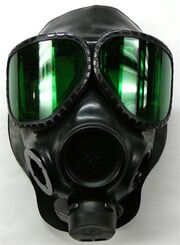
An M40A2 with the special Laser Protective Ballistic Lens Outserts. These are uncommon to find, and can be expensive when found.
supposedly resist light shrapnel. There are three kinds; the clear pair are used just for protecting the lenses and reducing fogging, a neutral gray pair are like a pair of sunglasses used to resist UV rays and "flashbang" grenades, and lastly, there are the rarer laser protective pair that have a green tint, meant to resist ruby and neodymium lasers, and are said to improve night vision.
M40/M42 "Quick Doff" Chemical Hood: Issued with the M40A1 as a replacement for the older First Generation M40/M42 Hood, which had the second skin sewn in which was prone to leaks, the "quick doff" hood is a very simple chemical hood, made of nylon fabric, heavily rubberized with butyl rubber, with a large, circular, elasticated opening for the mask, two underarm straps made of the same material as the hood with metal adjustment buckles in the back and black plastic fastening clips in the front. The neck area has a built in elastic band, as to not need a confusing, time consuming drawstring cord and slider. The hood is very easy to use and could be used with a variety of gas masks, U.S. or not.
Optical Inserts: A special pair of glasses that have special frames that fit around the inside the lenses, inside the

M40 Field Protective Masks in use. Note the optical inserts in the mask of the soldier laying down.
mask. There are two types - a plastic frame type and a metal wire frame type.
MI Waterproofing Bag: Standard in most U.S. protective masks from the Vietnam War and onwards, the MI waterproofing bag is a large plastic bag used to keep the mask dry when fording rivers and streams, or whenever the mask may be exposed to water. The bag can degrade the protective qualities of the mask, and can have toxic effects when the bag contacts foodstuffs. The bag comes with a cardboard sleeve of rubber bands meant to close the bag. The bag is stored folded in a ziploc bag in one of the internal or possibly external pockets of the mask's carrier bag.
Preventative Maintainance Service Check (PMSC) Flash Cards: Laminated flash cards on a metal ring that list problems and defects you need to check for on a certain basis for the M40 Series Field Protective Masks.
M40 To M42 Conversion Kit: The M42 is the armored crew member's version of the M40 Field Protective Mask. It had a voice diaphragm with a built in
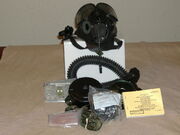
M40A2 with M42 Conversion Kit.
microphone, for the tank's radio, and a long breathing tube (green hose fixed to the facepiece on the M42, then a threaded black hose to switch sides for left and right handed tankers on the M42A1 and M42A2). The C2 or C2A1 filter on the end of the hose had a special plastic casing (olive drab green plastic with metal coupling on the M42, then a black plastic case with black plastic coupling on the M42A1 and M42A2), which had a special coupling on the inlet port so that a hose from the tank's supplied air system could be attached to it. Every other aspect of the M42 series masks besides the hose, microphone, and filter casing and coupling are the same was their M40 counterparts. The M40A1 and M40A2 could be issued with a special conversion kit to field modify it into an M42A1 or M42A2 armored crew member's mask because making a seperate mask for a different purpose was costly. The kit came with the hose, casing with coupling and carrying straps, and a special clip on microphone that clips to the main voice diaphragm.

An M40A1 with the M40 T.A.P. hood. It's remarkably similar to the M3 T.A.P. hood for the M9A1, with only minor differences. Worn here with the M2 T.A.P. Apron while inspecting drums of Distilled Mustard Gas for leaks.
T.A.P. Hood: Like the M9A1 with M3 T.A.P. Hood, and the MCU-2/P with the HGU-65/P T.A.P. Hood, the M40 Series has had it's own T.A.P. Hood, meant for heavy decontamination, chemical stockpile inspection/handling, and other similar tasks. T.A.P. hoods for the M40 are very rare, and understandably expensive when found, not many photos exist of the M40 T.A.P. hood exist as well, information is rare, and as of now, the actual desingnation for the hood is unknown.
As of now, there are only two copies of the M40 - South Korea has a distant copy known as the K-2, which is remarkably similar, aside from ths eyepiece shape, voice diaphragm style, and the way the mask was molded.

The Serbian M3, a copy of the U.S. M40.
The other copy of the M40 is the M3 from Serbia. It's also remarkably similar, however the voice diaphragm, filter, outlet valve and the size of the eyepieces (same shape as the M40) are slightly bigger than the M40. The drinking tube on the M3 is also very similar to the drinking tube used on the Canadian C4, because of the way it attaches under the left eyepiece and curls behind and under the filter inlet. As of now, none of these two copies exist in the U.S. and possibly outside the countries of origin.
The M40 Series was not only used by the Army and Marine Corps, it's widely documented (mainly through photographs) that the U.S. Navy (especially the Seabees) adopted the M40 as well as either a replacement or a partner mask to the MCU-2/P Chemical Protective Mask.
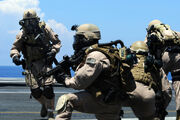
Members of the U.S. Navy Explosive Ordinance Disposal Mobile Unit 11 (EODMU 11) Wearing the M40A2 mask with the special PAPR blower filter system.
Another Navy unit that used the M40 was the Explosive Ordinance Disposal Mobile Unit 11 Team, but the mask was used with a special blower (PAPR) that had two C2 or C2A1 filter screwed on the front of it, the blower was worn on the belt or on the back, and the blower had an electric fan that sucked air through the filters and forced air through a long tube into the mask. The blower units are very rare, and are not usually found.
